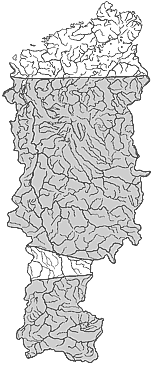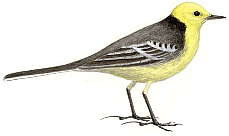|
|
| Main |
| Systematic List |
| Photo |
| Central Siberia |
| Guest book |
| Awards |
| SEARCH |
|---|
|
|
Motacillidae |
|---|
Citrine Wagtail Motacilla citreola Pallas, 1776
|
 Citrine Wagtails inhabit moist hummock meadows often overgrown with shrubs both in flatlands and mountains. Its range coincides mainly with the northern taiga subzone and the forest-tundra zone. The species is more typical of the Central Siberian Plateau than of the flat plains west of the Yenisey. The species has been presumed common in the Minusinsk depression but seems to occur only locally. P. P. Sushkin discovered it near Minusinsk on the edges of mixed forests in the foothills of the Sayan Mountains but failed to locate it on the Abakan steppe or in the Achinsk District (Sushkin 1914). In the Sayan Mountains, the species has been traced up to the open forest belt where it is found on meadows along the Ora River. All the pairs observed were nesting on hummock meadows overgrown with willows. V. I. Bezborodov reported up to 10 birds/km2 in the Koibal steppe (Bezborodov 1979). The most recent sources (Kim 1977; Sokolov et al. 1983; Petrov and Rudkovsky 1985; Prokofyev 1988) suggest that the Citrine Wagtail is a common species on alpine tundras and on moist hummock meadows around mountain lakes and rivers as well as in bogs but a rare one on meadow clearings along rivers. S.M. Prokofyev recorded the species as numerous in the Sayano-Shushensky Reserve on the upper reaches of the Bolshiye Ury River (Prokofyev 1988). He found densities of 19 birds/km2 inhabiting shrubby clearings with thickets and sedge hummocks near watercourses. In the East Sayan Mountains near Mana Lake, the species was found repeatedly on moist alpine tundra (Tugarinov 1913; Yudin 1952). According to the literature (Gladkov 1954; Stepanyan 1978), there may be a discontinuity in the species' distribution between the southern population of the Minusinsk depression and the Sayan Mountains and the northern population that breeds in the northern taiga and south to 59° N. Questions still remain concerning the precise nature of this distribution gap. In any case, R.L. Naumov failed to find the species near Kemchug, while it was numerous — 99 birds/km2 — in bogs in the Poyma River floodplain (Ravkin et al. 1988). Only single breeding reports have drifted in of Citrine Wagtails in peat bogs on watersheds near Pogodayevo and Fomka in Yenisey southern taiga (59°- 60° N). In Yenisey mid taiga, the Citrine Wagtail is a common migrant but a rare breeder. Males arrive first, mainly between May 2 and 26. By the end of May, about a dozen birds, mainly males, can be found near Mirnoye. The birds feed in shallow meltwater pools with sprouting grass. On the last days of May transit migrants pass through in flocks of several dozen birds. Individual pairs in transit were observed until June 12, and later, individuals could be found on the banks of the Yenisey and along its tributaries. These birds probably were breeding in the vicinity, somewhere in riverside habitats. Typically, though. Citrine Wagtails nest in the open wet peat bogs of watersheds. For example, on May 4, 1982, during a very early spring, a pair was found collecting nesting material in a small peat bog on the watershed separating the Verkhnyaya Sarchikha and the Razvilki Rivers. Similarly, the species was common near Sosnovoye Lake breeding in a vast open peat bog with inundated pits and narrow hills overgrown with moss. In June 1982, three pairs bred in a similar but smaller peat bog in the watershed separating the Dulkuma and Tanimakit Rivers. Flocks of juveniles appear in Mimoye between July 29 and August 12. Over the course of the second half of August, migratory Citrine Wagtails numerically displace the Yellow Wagtails which migrate somewhat earlier. In several of the last 10 years, up to 40 birds including many adults spent some time on a mown meadow near the station. On sand or mud banks of the Yenisey, the species can attain densities of 50 birds/10 km of shoreline. Migration intensity builds up through the first third of September, at the end of which peak numbers — 11 birds/km2 — are reached. At this point, the species may occur far from the Yenisey. Shortly thereafter, though, between September 11 and 15, the last birds pass through. It should be noted that autumn migration intensity varies widely from year to year. In Yenisey northern taiga, the species is a common, in places numerous breeder. There does not seem to be a density gradient from north to south. The population near Baklanikha (64°25' N) bred in densities of 27 birds/km2 on floodplain hummock meadows and of 7 birds/km2 in watershed peat bogs (Rogacheva and Vakhrushev 1983). Further north, in Yenisey forest-tundra at 68°- 69° N, Citrine Wagtails are numerous. For example, the breeding density in various habitats near Ust'-Khantayka, 68° 15' N, in the southern part of the subzone equalled 48 birds/km2 on moss-sedge tundra with peat hillocks, 16 on Yenisey floodplain meadows, and 0 in open forests. In the next subzone north, typical forest-tundra at Nikolskoye, 69° N, the respective densities equalled 18, 48, and 8 birds/km2 (Rogacheva et al. 1983). Further breeding data include the following: in the Putorana Mountains the species is common in the extreme northern taiga that flanks the Norilskiye Lakes as well as in the forest-tundra near the source of the Pyasina River. Individual breeding pairs are also found in the southern half of the typical tundra subzone (Krechmar 1966). On the upper Turukhan River to the west of the Yenisey, Citrine Wagtails are found regularly only in extreme northern taiga and in southern forest-tundra; the species is rare further north (Rogacheva et al. 1983). In eastern Taymyr, it is locally common in the forest-tundra areas containing larches that surround Khatanga. In the shrub tundra of the Ary-Mas Reserve, 72°30' N, it was common with 4.9 birds/km2 in open larch forests in 1983 in places where it was absent in 1981 (Chupin 1987). On fee other hand, fee species was truly numerous in shrub tundra along fee Yenisey estuary. All habitats around fee uninhabited settlement of Malaya Kheta were heavily occupied: 125-127 birds/km2 were recorded. The highest population densities were recorded in Ust'-Port, Karaul, Nosok, and Malaya Kheta (65-125 birds/km2), while it was only common (4-9 birds/km2) in moss tundra wife low shrubs — except in fee vicinity of Malaya Kheta (Ravkin and Gleich 1981). Finally, further north fee species' range spills into fee south of fee typical tundra subzone along fee Yenisey Bay; there is disagreement as to how far north. A.Ya. Tugarinov suggests 71° N as fee northern breeding limit, but according to F.D. Pleske fee range stretches to 72° N. |
[Back] |
|
|
|
|
Сайт разработан и поддерживается кафедрой прикладной экологии и ресурсоведения СФУ
